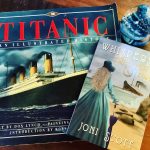- in Author Blogs by admin
Whispers through time in 1912 The Titanic – Author Academy Bookstore

Even after its sinking on an icy cold April night long ago in 1912, the Titanic has proved to be an unsinkable story of human tragedy.
Indeed, The RMS Titanic lives on as a cautionary tale of what can go wrong when ego and monetary concerns overpower responsibility and safety. This tragic tale endlessly fascinates us despite the ship’s loss to the icy depths of the Atlantic over a century ago. The ill-fated Titanic is the subject of many books such as the definitive A Night to Remember by Walter Lord (1956) and Titanic, An Illustrated History by Don Lynch (1992). It features in Stephen Weir’s book, History’s Worst Decisions and is even the inspiration for a children’s book called Polar, the Titanic Bear, about the actual teddy bear of a little boy who survived the sinking. Speaking of which, there is one last book I just have to mention that is also a fascinating read. Shadow of the Titanic follows the lives of the survivors of that terrible night. Interestingly, most of them had sad lives and many died young and even quite soon after the event. The little boy who owned the teddy bear died in a family car crash within a year and is just one example of the long shadow that the Titanic cast over people’s lives. Some folk never recovered from family losses while others bore survivor’s guilt that prevented their happiness.
Yes, the Titanic story is one that keeps on giving. There is so much to fascinate, so many lessons about human nature to appreciate.
As a long-time enthusiast of all things Victorian, the story interested me long before the blockbuster 1997 Titanic film produced by James Cameron. I had already watched the earlier film starring Barbara Stanwick and seen and read films and books where the Titanic had sailed in, creating a setting for many tragic storylines. I confess to Titanic jigsaws and scale models as well.
But all the tragedy could have been averted if someone like Bruce Ismay, Captain Smith or the ship builder, Thomas Andrew had read another book by a little-known author named Morgan Robertson. In 1898, he wrote a novel about a transatlantic liner loaded with the rich and famous that hit an iceberg near Newfoundland at similar co-ordinates. The ship, eerily called the Titan had very similar specifications to the actual Titanic.
If only someone had read this book, aptly titled Futility.
It is telling of human nature that we are drawn to details of tragedies. Perhaps it is because there is so much to take away and reflect on. The factors that caused the tragedy are themselves endlessly fascinating. In this instance there were a myriad of fateful errors both human and natural. Titanic was steaming ahead in an ill-fated race with Time itself. Captain, Edward Smith confidently ordered her throttled into full steam so she could arrive in New York ahead of schedule. He along with Bruce Ismay, director of White Star Line wanted to showcase her capabilities as the biggest ship ever to sail the seas. It was Smith’s last commission at sea so this would be a fitting end to his career. A timely six day crossing of the Atlantic was important for both men.
Neither man seemed concerned by reported ice warnings in the ocean ahead, nor overly mindful of their responsibility to the cargo of 2240passengers, despite the paucity of lifeboats. The Titanic had everything anyone could want on board a ship except lifeboats. Even at two thirds capacity of its possible number of passengers there were only enough for 1178 people, leaving 1023 others stranded. That is only too if the lifeboats were fully loaded which was definitely not the case. Many that could take 65 people, left with less than twenty aboard. Some of these fortunate were extremely wealthy and influential women along with children and even first-class men. Most second and third-class passengers went down with the ship.
If it were not for the speed, the inattention to ice, the lowered bulkheads, the limited life-boats, the missing binoculars on the watch deck, the steel, the pop rivets, the last-minute attempt to swerve around the iceberg…. So may ‘ifs, so many factors that coalesced to cause tragedy.
Then apart from the ship’s construction, the speed and human factors there was the bad luck that the only nearby ship, the Californian turned off its telegram service and retired all staff to bed. Even after sighting a flare rocket. ‘We thought it was a just a party,’ the captain claimed in defense. Words that went down in history like those of Captain Smith. ‘I cannot imagine any condition which would cause a ship to founder. Modern shipbuilding has gone beyond that.’
There is so much more I could write about this Titanic subject. Many have. Instead, I chose some human-interest snippets to include in two chapters of my historical fiction novel, Whispers through Time. This book is based on my grandparent’s journey from London to Australia on a steamer ship, the Rangatira in June 1912, just months after the sinking of the ill-fated liner. The tragedy was recent news. It is a wonder they still travelled into the ice infested waters of the southern oceans. But they did and even retraced the journey two years later through U boat infested waters to return to England as grandfather was called into military service. He was still part of the British Army, having served already in the Boer Wars when he was just sixteen. Their story continues on in the sequel released this year, Time, Heal my Heart.
Follow my history blogs on https://joniscottauthor.com
Australian readers check out Author Academy Bookstore, https://authoracademybookstore.com.au
